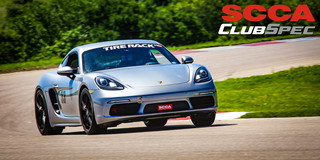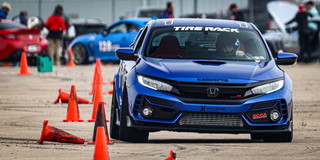
This article first appeared in the April, 2016 edition of SportsCar Magazine. SCCA members can read the current and past editions of SportCar digitally here after logging into their account; To become an SCCA member and get SportsCar mailed to your home address monthly in addition to the digital editions, click here.
I hate to bring this up, but think about your last crash. Could you see it? Yes, I’m serious. If you could, you were most likely understeering. When you’re backwards, you don’t get to see the impact. That would be oversteer.
Understeer is your friend, because it’s far easier to control. It’s like Dad – a gentle guiding hand, who won’t spank you unless you really deserve it, and hopefully teach you a lesson. Understeer is when the front tires are sliding more than the rear. Racers often refer to it as a push. Especially down here in the South. Sorry if I’m talking down to you, dear readers, but let’s define for those with Xs on the rear of their racecars (the “Rookie Warning Mark of Danger”).
Historically, manufacturers deliberately tune their cars to understeer. Why? Because it creates stability. Stability saves on legal bills later. George and Martha stay on the road when swerving violently around the errant toddler on his big wheel, since they probably have never driven in Solo, and don’t know how to handle simple offset gates. But, for us in the racing world, what is the benefit of that? After all, we drive flat-out, do we not? Out on the ragged edge.
Confidence, that’s the payoff. It is invaluable to the driver. The outstanding benefit of understeer. Confidence comes from knowing what to expect. From being able to control what’s next. A little understeer keeps the tail in line when going deep, deep, deep into the brake zone to take the lead. A little understeer makes it much easier to keep the car on the absolute limit of traction and fill the friction circle as you blend straight hard braking into 1.5g cornering.
Think about it. Where is the weight when you are braking? All forward. How’s the rear? Light. Very light. Does this sound stable to you? It’s not. If your car is a little tail happy, this will only get worse. A little understeer gives the driver something to lean on – a safe landing zone for the dive bomb.
It’s the middle of the corner where understeer can be a frustration. Understeer demands patience. An impetuous early application of power moves that braking weight back to the rear. The front gets light and loses grip. Part-throttle exaggerates any tendency to understeer. Early throttle is why many amateur track cars I drive end up with too much oversteer. See what I mean here? Regular Joe often finishes braking early, and next, naturally, goes to the power early, taking load off the front early, creating understeer. So, Regular Joe stiffens the rear swaybar to eliminate that mid-corner understeer. If a chassis is set up to be perfectly balanced with early acceleration – a very common mistake – it will likely be too loose everywhere else. I’ll tell you, I’ve rocked several people’s worlds by just stiffening the front swaybar. Always consider: is the handling trait you hate, the car or is it you?
Exiting a turn flat-out, in a rear or good four-wheel drive, should evidence very little understeer. All the power is twisting the back tires, adding slip angle. Driving off a corner in a sweet, small power drift is one of the most rewarding moments in motorsports, made possible by a stable platform with a one to two understeer, on a scale of 10.
So, understeer is a good thing for the vast majority of drivers, on and off track. But some drivers are so good at counter steering that this is not a factor. I blame karting. Karts are fastest driven in a constant state of oversteer. Or just the drifting gene. If you must share a car with one of these aliens, get your skid pad training in first.
An ideal setup will have enough understeer for the confidence-inspiring stability that every driver needs to go really fast. Having a car under you, the Indy racers used to say. Too much understeer will make you feel frustrated. Sense your mood, it tells you how your car is handling. When you find yourself waiting on the front end, waiting for the car to point at the apex, waiting to floor the gas pedal, pushing wide, pushing wide, missing your apex, it’s frustrating.
So, how do you compensate for that push? Pull those levers to adjust your swaybars, stiffer front, softer rear. There have been Porsches I’ve driven where I start full one way – soft front, hard rear – then by the end of the stint, the bars are fully the opposite – hard front, soft rear – as fuel load lightens nose and rear tire wear. That’s life in older 911s.
But most racers do not have this luxury – it’s even illegal in many series – and it’s pointless pitting to change your bars in an SCCA Club race. So, compensate with your driving. Turn a little earlier. You have to, because you know the car does not turn well, so it takes more time. And trail brake. Understeer equals trail brake. The front tires are begging for more load. Brake very lightly as you turn in, for a long time, until you know you will make the apex. This is a great speed secret.
Further, be patient on the throttle, because what does it do to your weight? Sends it rearward. Wait, wait, wait on power in an understeering car. Turn early, but apex late, so you can straighten the wheel when you finally add power, and take advantage of a benefit of understeer; power down traction. Exit speed is king, not apex speed.
Plan B? Gas it early and drive with the throttle, North Georgia Redneck style (by the way, four-time Pirelli World Challenge GT Champ Johnny O’Connell and I live only a mile apart outside Atlanta). Power oversteer is loads of fun, and I truly wish it was the fastest way. It is the hot tip on dirt: let’s SCCA RallyCross! But it’s really hard on rear tires on pavement. Too bad. A little bit is fine, but a lot will ruin your on-track life.
Understeer. Maybe not the most entertaining, but if you want to win, recognize that a little of it is your friend, and get by with a little help from your friend.
Words by Randy Pobst
Image by John W. Wilmoth










